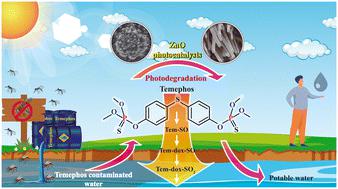当前位置:
X-MOL 学术
›
Environ. Sci.: Nano
›
论文详情
Our official English website, www.x-mol.net, welcomes your
feedback! (Note: you will need to create a separate account there.)
Tracing the degradation pathway of temephos pesticide achieved with photocatalytic ZnO nanostructured films
Environmental Science: Nano ( IF 5.8 ) Pub Date : 2022-08-19 , DOI: 10.1039/d2en00384h Amauri Serrano-Lázaro 1 , Francisco Alberto Verdín-Betancourt 2 , Vinoth Kumar Jayaraman 1, 3 , Agileo Hernández-Gordillo 1 , Ma. de Lourdes López-González 2 , Adolfo Sierra-Santoyo 2 , Guillermo Santana 1 , Monserrat Bizarro 1
Environmental Science: Nano ( IF 5.8 ) Pub Date : 2022-08-19 , DOI: 10.1039/d2en00384h Amauri Serrano-Lázaro 1 , Francisco Alberto Verdín-Betancourt 2 , Vinoth Kumar Jayaraman 1, 3 , Agileo Hernández-Gordillo 1 , Ma. de Lourdes López-González 2 , Adolfo Sierra-Santoyo 2 , Guillermo Santana 1 , Monserrat Bizarro 1
Affiliation

|
Temephos (Tem) pesticide is a permitted and widely used compound to control vector-borne diseases. Unfortunately, temephos easily undergoes fast photooxidation under ambient conditions, forming more toxic subproducts, which may cause DNA damage with its prolonged use. Semiconductor photocatalysis has proven to be an effective method to degrade toxic pollutants (including pesticides) in water, with zinc oxide (ZnO) being one of the most representative photocatalysts. In this work, the evolution of Tem and three of its principal subproducts (Tem-SO, Tem-dox-SO, and Tem-dox-SO2) was monitored using high-performance liquid chromatography (HPLC) during a simulated-sunlight photocatalytic treatment using two different ZnO nanostructured morphologies, flower-like (FL) and nanowire (NW) films. ZnO films with NW morphology were three times faster than FL in degrading Tem. NW also degraded Tem subproducts efficiently, achieving a high mineralization percentage. Their large surface area, point defects, and the contribution of Au nanoparticles on the tip of the NWs that possibly produced a surface plasmon resonance effect, enhanced visible light absorption and charge separation. These characteristics all together led to a higher production of hydroxyl radicals responsible for the degradation and mineralization of Tem and Tem subproducts. The monitoring of Tem derivatives indicated that the degradation process occurs in three stages.
中文翻译:

用光催化氧化锌纳米结构薄膜追踪替美磷农药的降解途径
Temephos (Tem) 农药是一种获准使用且广泛使用的化合物,可用于控制病媒传播疾病。不幸的是,temephos 在环境条件下很容易发生快速光氧化,形成毒性更大的副产物,长期使用可能会导致 DNA 损伤。半导体光催化已被证明是降解水中有毒污染物(包括农药)的有效方法,其中氧化锌(ZnO)是最具代表性的光催化剂之一。在这项工作中,Tem 及其三个主要子产品(Tem-SO、Tem-dox-SO 和 Tem-dox-SO 2) 在模拟阳光光催化处理期间使用高效液相色谱 (HPLC) 监测,使用两种不同的 ZnO 纳米结构形态,花状 (FL) 和纳米线 (NW) 薄膜。具有 NW 形态的 ZnO 薄膜在降解 Tem 方面比 FL 快三倍。NW 还有效地降解了 Tem 子产品,实现了高矿化百分比。它们的大表面积、点缺陷以及金纳米粒子在纳米线尖端的贡献可能产生表面等离子体共振效应、增强可见光吸收和电荷分离。这些特性共同导致产生更多的羟基自由基,导致 Tem 和 Tem 子产品的降解和矿化。
更新日期:2022-08-19
中文翻译:

用光催化氧化锌纳米结构薄膜追踪替美磷农药的降解途径
Temephos (Tem) 农药是一种获准使用且广泛使用的化合物,可用于控制病媒传播疾病。不幸的是,temephos 在环境条件下很容易发生快速光氧化,形成毒性更大的副产物,长期使用可能会导致 DNA 损伤。半导体光催化已被证明是降解水中有毒污染物(包括农药)的有效方法,其中氧化锌(ZnO)是最具代表性的光催化剂之一。在这项工作中,Tem 及其三个主要子产品(Tem-SO、Tem-dox-SO 和 Tem-dox-SO 2) 在模拟阳光光催化处理期间使用高效液相色谱 (HPLC) 监测,使用两种不同的 ZnO 纳米结构形态,花状 (FL) 和纳米线 (NW) 薄膜。具有 NW 形态的 ZnO 薄膜在降解 Tem 方面比 FL 快三倍。NW 还有效地降解了 Tem 子产品,实现了高矿化百分比。它们的大表面积、点缺陷以及金纳米粒子在纳米线尖端的贡献可能产生表面等离子体共振效应、增强可见光吸收和电荷分离。这些特性共同导致产生更多的羟基自由基,导致 Tem 和 Tem 子产品的降解和矿化。











































 京公网安备 11010802027423号
京公网安备 11010802027423号